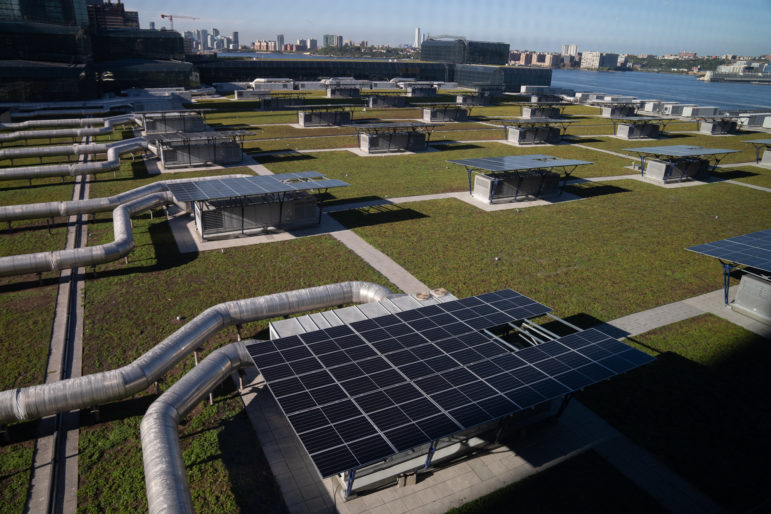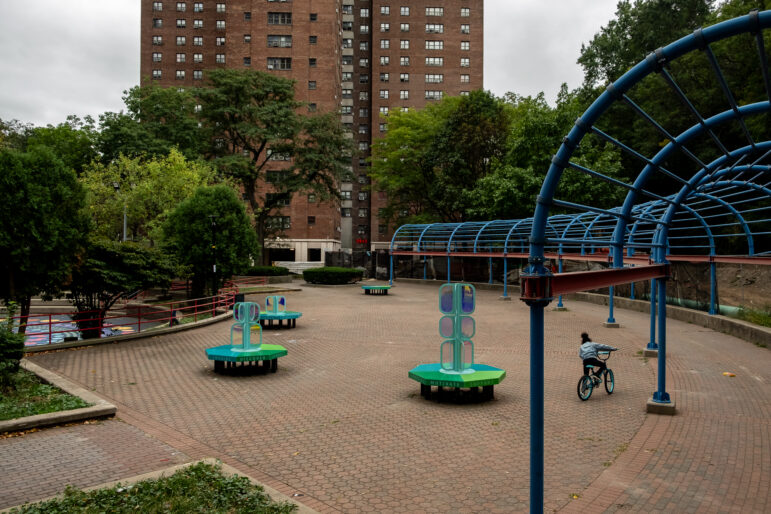New York now has enough solar energy to power 1 million homes. Environmentalists say it’s crucial for the state to keep that momentum as it falls behind on meeting other climate goals.

Adi Talwar
Solar power panels at the Sherman Terrace co-op in the South Bronx.The year comes to a close with New York falling behind on hitting almost every target laid out by its landmark climate law, the Climate Leadership and Community Protection Act (CLCPA).
The original plan sought to phase out the polluting fossil fuels driving climate change, requiring that 70 percent of New York’s electricity come from renewable sources by 2030. But government officials announced this summer that the goal post will be pushed back by three years.
It’s not all bad news, however. The state is actually on track to hit deadlines outlined in the climate law for the development of solar energy.
In October, the state announced that New York had hit the goal of producing 6 gigawatts (GW) of distributed solar by 2025, a year ahead of schedule. That’s enough to power approximately 1 million homes.
“We are obviously having some challenges in reaching the goals outlined by the CLCPA, so I think it’s good to highlight a success story,” said Patrick McClellan, policy director at New York League of Conservation Voters (NYLCV).
Part of solar’s success can be attributed to the fact that the price to build solar systems has decreased, from $3.77 per watt in 2016 to $2 per watt by 2024, according to the NYLCV.
Another huge boost to the sector has been the rise of the community solar market, which allows multiple customers hooked on to the system to receive credits on their monthly electric bills for their share of the clean electricity produced. That means people across New York can tap into solar power without having to install panels on their own property.
The statistics on the rise of solar installments across the state reflect that growth. New York is currently home to over 235,000 solar projects, which includes both on-site installations on a property and community solar projects.
And immense progress has been made over the last 20 years. In 2002, the state produced its first megawatt of power from solar, NYLCV says. By 2020 the megawatt count had jumped to 2,848; it had more than doubled two years after that, to 4,466. Now in 2024, the state has reached its 6 gigawatt goal. One gigawatt is equal to 1,000 megawatts.
But some experts question if New York can keep up that pace now that it has already built out the solar farms that were easier to get off the ground.
“In upstate New York, there’s a fair amount of farmland and other large plots that are good sites to build solar. These [plots], which we can call low-hanging fruit, have already been developed,” said T.R Ludwig, co-founder of the solar company Brooklyn SolarWorks.

Gov. Hochul’s Office
Solar panels on the roof of the Javits Center in Manhattan.In New York City, where there isn’t a ton of open space, solar panels mostly go up on people’s roofs. And that presents challenges: the city’s current fire code says rooftops must include a clear path of no less than six feet for big buildings, and four feet for more compact ones, so firefighters can circulate when there is an emergency. But the requirements make it hard for solar panels to fit on most city roofs.
And other more overarching issues could slow down the growth of solar in New York, Ludwig says: conservative groups upstate, where resistance against solar farms has been mounting, could change zoning regulations to make it more difficult to install panels.
There’s also fear that President-Elect Donald Trump will make due on his promise to rescind unspent dollars from the Biden-era Inflation Reduction Act (IRA), which injected billions into bolstering the green economy by distributing money for clean energy projects, including in New York.
“From now on it’s just going to get more challenging and we will see more roadblocks. Developing solar will become more difficult in New York as the political tides turn,” Ludwig said.
To counteract the federal threat, environmentalists say New York needs to keep building on the solar front, from amending the city’s fire code to make it easier to install panels to raising the bar when it comes to setting gigawatt goals for the future.
“Given that the state’s other [renewable energy goals] are super behind, why not double down or emphasize what has actually been working to help us still achieve the climate mandates that the state has,” said Daniel Chu, senior energy planner at the New York City Environmental Justice Alliance.
To reach the reporter behind this story, contact Mariana@citylimits.org. To reach the editor, contact Jeanmarie@citylimits.org
Want to republish this story? Find City Limits’ reprint policy here.







